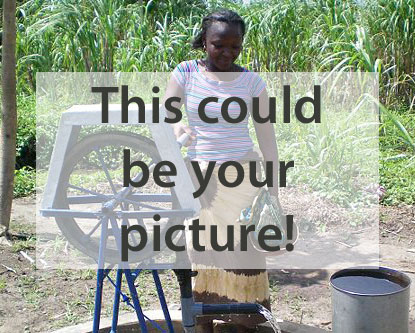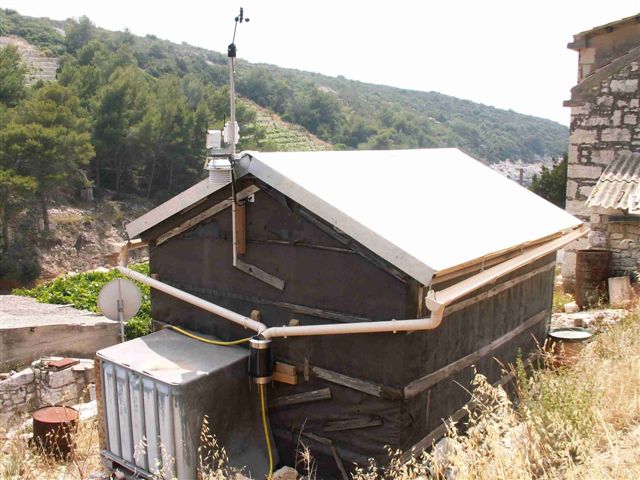Difference between revisions of "Water Portal / Rainwater Harvesting / Rooftop rainwater harvesting"
| Line 5: | Line 5: | ||
In many cases, groundwater or surface water may be unavailable for drinking water. The groundwater level may be too deep, groundwater may be contaminated with minerals and chemicals such as arsenic or salt, surface water may be contaminated with faeces or chemicals. In these cases, rainwater harvesting can be an effective and low-cost solution. | In many cases, groundwater or surface water may be unavailable for drinking water. The groundwater level may be too deep, groundwater may be contaminated with minerals and chemicals such as arsenic or salt, surface water may be contaminated with faeces or chemicals. In these cases, rainwater harvesting can be an effective and low-cost solution. | ||
| − | |||
| − | |||
| − | |||
| − | |||
==History and social context== | ==History and social context== | ||
| Line 15: | Line 11: | ||
A rainwater harvesting system might be a 500 cubic meter underground storage tank, serving a whole community, or it might be just a bucket, standing underneath a roof without a gutter. Each 20 litre container of clean water might save a kilometers long walk to the nearest source of clean water, and as fetching water on cold, wet and slippery days is particularly unpleasant, even this small yield is highly valued. In Uganda and Sri Lanka, rainwater is traditionally collected from trees, using banana leaves or stems as temporary gutters. | A rainwater harvesting system might be a 500 cubic meter underground storage tank, serving a whole community, or it might be just a bucket, standing underneath a roof without a gutter. Each 20 litre container of clean water might save a kilometers long walk to the nearest source of clean water, and as fetching water on cold, wet and slippery days is particularly unpleasant, even this small yield is highly valued. In Uganda and Sri Lanka, rainwater is traditionally collected from trees, using banana leaves or stems as temporary gutters. | ||
| − | + | ||
==Suitable conditions == | ==Suitable conditions == | ||
| Line 26: | Line 22: | ||
==Technical specification== | ==Technical specification== | ||
| + | The flow of water can be intercepted in different ways. Different catchment types are used, such as roof catchment, paved surface catchment, surface catchment and riverbed catchment. Once the water has been intercepted, it is led to a storage tank. Usually, a filter is placed between the catchement structure and the storage tank. | ||
| + | |||
| + | Generally, structures made with ferrocement, or brick-cement are the best and cheapest option, and they can be made locally. When a water tank is below ground, it is called a cistern. Among the different storage types are the [[underground tank]], [[ferro-cement tank]], [[plastic-lined tank]], etc. The size of the tank is a compromise between cost, the volume of water used, the length of the dry season, etc. | ||
| + | |||
| + | Several pump systems can be used to lift the water from underground tanks, for example with a [[rope pump]] or with a [[deep well pump]], which can elevate water up to a height of 30 m. | ||
| + | |||
| + | The cheapest storage of all is to use the ground as storage area, a technique called groundwater recharge. It is accomplished by letting rainwater infiltrate in the ground. The recharge will locally lead to a higher water table, from which water can be pumped up when needed. Whether the infiltrated water raises the water table in a local area or is spread across a wider area depends on soil conditions. | ||
====Operation==== | ====Operation==== | ||
| + | Roof rainwater is usually of good quality and does not require treatment before consumption. The most important thing to ensure water quality is a good lid, keeping out light and insects, and a filter, keeping out all kinds of dirt. | ||
====Maintenance==== | ====Maintenance==== | ||
| Line 36: | Line 40: | ||
==Country experiences== | ==Country experiences== | ||
| + | Rainwater harvesting is a technology which is extremely flexible and adaptable to a wide variety of settings, it is used in the richest and poorest societies on the planet, and in the wettest and driest regions of the world. | ||
==Manuals== | ==Manuals== | ||
| + | *[http://www.irc.nl/page/37471 Download the book "Roofwater Harvesting: A Handbook for Practitioners" from the IRC website] | ||
==Movies== | ==Movies== | ||
* [http://www.thewaterchannel.tv/index.php?option=com_hwdvideoshare&task=viewvideo&Itemid=53&video_id=144 Rainwater Harvesting Nepal, by BSP-Nepal] | * [http://www.thewaterchannel.tv/index.php?option=com_hwdvideoshare&task=viewvideo&Itemid=53&video_id=144 Rainwater Harvesting Nepal, by BSP-Nepal] | ||
* [http://www.youtube.com/watch?v=QaTYxX_jajs Rooftop Rainwater harvesting India], by Zenrainman, [http://www.rainwaterclub.org], documenting the Sachetana programme of the government of Karnataka, India. | * [http://www.youtube.com/watch?v=QaTYxX_jajs Rooftop Rainwater harvesting India], by Zenrainman, [http://www.rainwaterclub.org], documenting the Sachetana programme of the government of Karnataka, India. | ||
| − | * [http:// | + | *[http://www.youtube.com/watch?v=wWnhYIIKY0U Indian movie by CSE (www.cseindia.org) promoting use of rainwater harvesting] |
==External links== | ==External links== | ||
* [http://www.rainfoundation.org Rainwater Harvesting Implementation Network (RAIN)] | * [http://www.rainfoundation.org Rainwater Harvesting Implementation Network (RAIN)] | ||
| − | * [http://www.rainwaterharvesting.org www.rainwaterharvesting.org ] | + | * [http://www.rainwaterharvesting.org www.rainwaterharvesting.org, Indian website on rainwater harvesting ] |
| + | * [http://en.wikipedia.org/wiki/Rainwater_harvesting Wikipedia article on rainwater harvesting] | ||
| + | |||
==References== | ==References== | ||
{{Joinus}} | {{Joinus}} | ||
Revision as of 11:19, 24 December 2009
Rainwater harvesting refers to structures which catch rainwater and store it in underground or above-ground tanks for later use. Any suitable roof surface — tiles, metal sheets, plastics, but not grass or palm leaf — can be used to intercept the flow of rainwater and provide a household with high-quality drinking water. Rainwater harvesting systems have been used since antiquity, and examples abound in all the great civilizations throughout history.
In many cases, groundwater or surface water may be unavailable for drinking water. The groundwater level may be too deep, groundwater may be contaminated with minerals and chemicals such as arsenic or salt, surface water may be contaminated with faeces or chemicals. In these cases, rainwater harvesting can be an effective and low-cost solution.
History and social context
Rainwater falls on your own roof, and is almost always of excellent quality. It enables people to manage their own water supply and provides the luxury of “water without walking”, relieving the burden of water carrying, particularly for women and children. This convenience is available at every house on which rain falls, whether on a mountain top or an island in a salt sea.
A rainwater harvesting system might be a 500 cubic meter underground storage tank, serving a whole community, or it might be just a bucket, standing underneath a roof without a gutter. Each 20 litre container of clean water might save a kilometers long walk to the nearest source of clean water, and as fetching water on cold, wet and slippery days is particularly unpleasant, even this small yield is highly valued. In Uganda and Sri Lanka, rainwater is traditionally collected from trees, using banana leaves or stems as temporary gutters.
Suitable conditions
| Advantages | Disadvantages/limitations |
|---|---|
| - Possible in almost any climate - Rainwater is good quality water |
- Storage is needed to bridge dry periods |
Technical specification
The flow of water can be intercepted in different ways. Different catchment types are used, such as roof catchment, paved surface catchment, surface catchment and riverbed catchment. Once the water has been intercepted, it is led to a storage tank. Usually, a filter is placed between the catchement structure and the storage tank.
Generally, structures made with ferrocement, or brick-cement are the best and cheapest option, and they can be made locally. When a water tank is below ground, it is called a cistern. Among the different storage types are the underground tank, ferro-cement tank, plastic-lined tank, etc. The size of the tank is a compromise between cost, the volume of water used, the length of the dry season, etc.
Several pump systems can be used to lift the water from underground tanks, for example with a rope pump or with a deep well pump, which can elevate water up to a height of 30 m.
The cheapest storage of all is to use the ground as storage area, a technique called groundwater recharge. It is accomplished by letting rainwater infiltrate in the ground. The recharge will locally lead to a higher water table, from which water can be pumped up when needed. Whether the infiltrated water raises the water table in a local area or is spread across a wider area depends on soil conditions.
Operation
Roof rainwater is usually of good quality and does not require treatment before consumption. The most important thing to ensure water quality is a good lid, keeping out light and insects, and a filter, keeping out all kinds of dirt.
Maintenance
Manufacturing
Cost
Country experiences
Rainwater harvesting is a technology which is extremely flexible and adaptable to a wide variety of settings, it is used in the richest and poorest societies on the planet, and in the wettest and driest regions of the world.
Manuals
Movies
- Rainwater Harvesting Nepal, by BSP-Nepal
- Rooftop Rainwater harvesting India, by Zenrainman, [1], documenting the Sachetana programme of the government of Karnataka, India.
- Indian movie by CSE (www.cseindia.org) promoting use of rainwater harvesting
External links
- Rainwater Harvesting Implementation Network (RAIN)
- www.rainwaterharvesting.org, Indian website on rainwater harvesting
- Wikipedia article on rainwater harvesting
References

|

